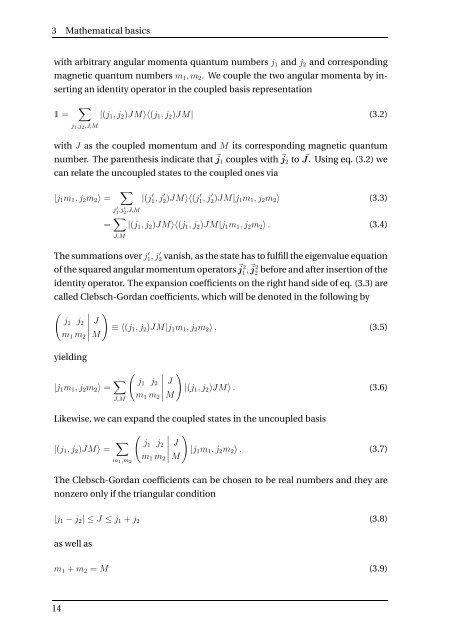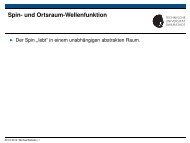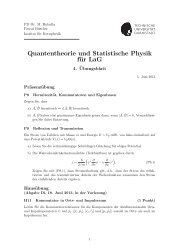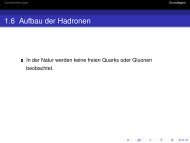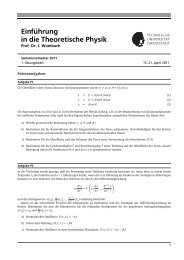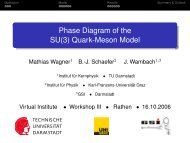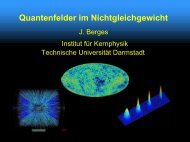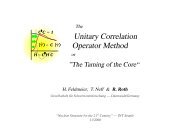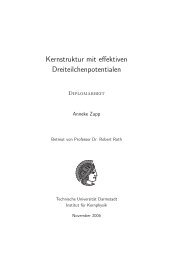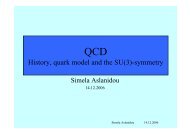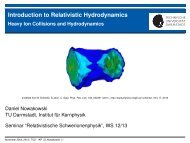Consistent chiral three-nucleon interactions in ... - Theory Center
Consistent chiral three-nucleon interactions in ... - Theory Center
Consistent chiral three-nucleon interactions in ... - Theory Center
Create successful ePaper yourself
Turn your PDF publications into a flip-book with our unique Google optimized e-Paper software.
3 Mathematical basics<br />
with arbitrary angular momenta quantum numbers j1 and j2 and correspond<strong>in</strong>g<br />
magnetic quantum numbers m1, m2. We couple the two angular momenta by <strong>in</strong>-<br />
sert<strong>in</strong>g an identity operator <strong>in</strong> the coupled basis representation<br />
1 = <br />
j1,j2,J,M<br />
|(j1, j2)JM〉〈(j1, j2)JM| (3.2)<br />
with J as the coupled momentum and M its correspond<strong>in</strong>g magnetic quantum<br />
number. The parenthesis <strong>in</strong>dicate that j1 couples with j2 to J. Us<strong>in</strong>g eq. (3.2) we<br />
can relate the uncoupled states to the coupled ones via<br />
|j1m1, j2m2〉 = <br />
j ′ 1 ,j′ 2 ,J,M<br />
|(j ′ 1 , j′ 2 )JM〉〈(j′ 1 , j′ 2 )JM|j1m1, j2m2〉 (3.3)<br />
= <br />
|(j1, j2)JM〉〈(j1, j2)JM|j1m1, j2m2〉 . (3.4)<br />
J,M<br />
The summations over j ′ 1 , j′ 2<br />
vanish, as the state has to fulfill the eigenvalue equation<br />
of the squared angular momentum operatorsj 2 1 ,j 2 2 before and after <strong>in</strong>sertion of the<br />
identity operator. The expansion coefficients on the right hand side of eq. (3.3) are<br />
called Clebsch-Gordan coefficients, which will be denoted <strong>in</strong> the follow<strong>in</strong>g by<br />
<br />
j1 j2<br />
m1 m2<br />
yield<strong>in</strong>g<br />
<br />
<br />
J<br />
≡ 〈(j1, j2)JM|j1m1, j2m2〉 , (3.5)<br />
M<br />
|j1m1, j2m2〉 = <br />
<br />
J,M<br />
j1 j2<br />
m1 m2<br />
<br />
<br />
J<br />
|(j1, j2)JM〉 . (3.6)<br />
M<br />
Likewise, we can expand the coupled states <strong>in</strong> the uncoupled basis<br />
|(j1, j2)JM〉 = <br />
m1,m2<br />
<br />
j1 j2<br />
m1 m2<br />
<br />
<br />
J<br />
|j1m1, j2m2〉 . (3.7)<br />
M<br />
The Clebsch-Gordan coefficients can be chosen to be real numbers and they are<br />
nonzero only if the triangular condition<br />
|j1 − j2| ≤ J ≤ j1 + j2<br />
as well as<br />
(3.8)<br />
m1 + m2 = M (3.9)<br />
14


